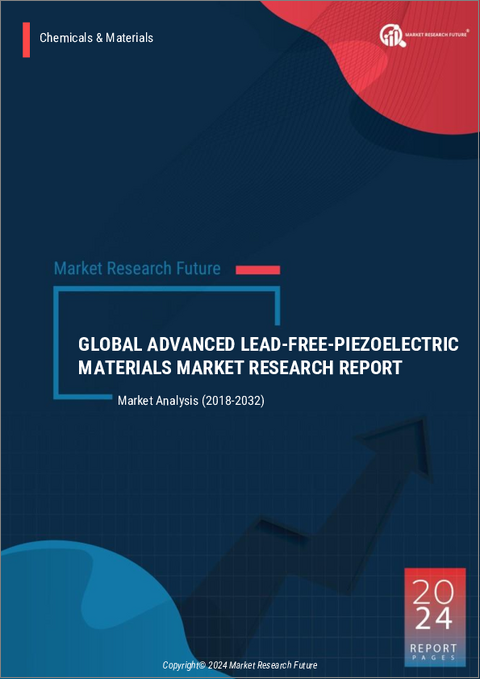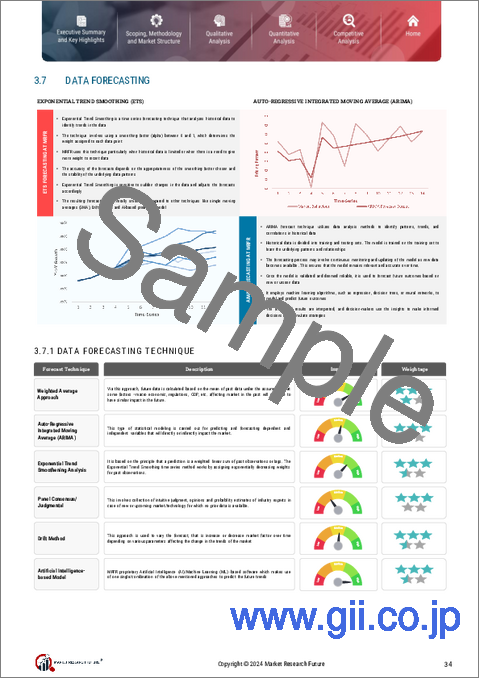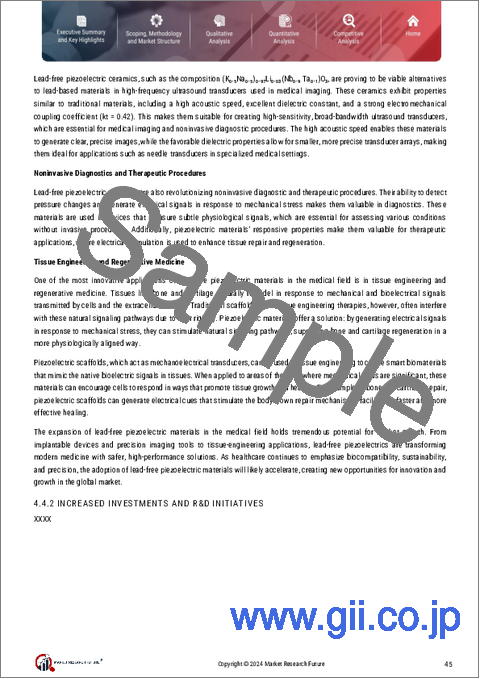|
|
市場調査レポート
商品コード
1665922
先進無鉛圧電材料の世界市場:タイプ (セラミックス・複合材料・その他)・用途 (自動車・CE製品・医療・その他)・地域別の予測 (~2032年)Global Advanced Lead-Free Piezoelectric Materials Market Research Report: Information by Type (Ceramics, Composites, and Others) By Application (Automotive, Consumer Electronics, Medical, and Others) and By Region Forecast to 2032 |
||||||
|
|||||||
| 先進無鉛圧電材料の世界市場:タイプ (セラミックス・複合材料・その他)・用途 (自動車・CE製品・医療・その他)・地域別の予測 (~2032年) |
|
出版日: 2025年01月14日
発行: Market Research Future
ページ情報: 英文 142 Pages
納期: 即納可能
|
全表示
- 概要
- 図表
- 目次
世界の先進無鉛圧電材料の市場規模は、2023年の1億40万2,800米ドル、2024年の1億2,670万8,300米ドルから、予測期間中は21.4%のCAGRで推移し、2032年には5億9,627万8,700米ドルの規模に成長すると予測されています。
無鉛圧電材料の世界市場は、医療および自動車分野でのこれらの材料の採用が拡大していることに加え、チタン酸ジルコン酸鉛 (PZT) などの従来の鉛ベースの代替材料に関する環境および健康への懸念が浮上していることから、大幅な拡大が見込まれています。植え込み型ドラッグデリバリーデバイス、医療用画像処理、超音波トランスデューサなどの用途では、ニオブ酸カリウムナトリウム (KNN) や窒化アルミニウム (AlN) などの無鉛代替材料が、高性能と生体適合性を提供することでその実行可能性を実証しています。これらの材料は、組織工学や再生医療において、自然の生体電気信号を再現することで骨や軟骨の再生を促進し、組織の成長を促進するスマートな骨格を構築するために使用されています。
欧州のRoHS指令などの厳しい規制要件に対応するため、各企業が高性能の無鉛圧電体の開発に取り組んでいるため、市場は強力な研究開発イニシアチブと投資の増加によってさらに支えられています。CTS、Ionix、Niterraなどの企業によって、革新的な技術と新しい無鉛処方が開拓されています。例えば、CTSのLFシリーズのKNNベースの材料は、高精度の設定においてPZTの性能に匹敵します。Ionixは産業環境向けの耐久性のある無鉛・ソリューションに注力しており、Niterraは無鉛材料の発見を加速するために材料情報学を活用しています。
地域別展望
欧州市場は予測期間中にかなりの収益シェアを示し、最大のシェアを維持すると予測されています。従来の鉛ベースの圧電材料に代わる、環境に優しい圧電材料への需要が拡大しているため、欧州の先進無鉛圧電材料市場は成長しています。ニオブ酸カリウムナトリウム (KNN)、チタン酸バリウム、チタン酸ビスマスナトリウムは、エネルギー、ヘルスケア、自動車、エレクトロニクスなどさまざまな分野で人気を集めている新興材料のひとつです。
無鉛圧電材料は、エネルギーハーベスティングデバイス、超音波装置、アクチュエーター、センサーに広く使用されている結果、需要が拡大しています。欧州がグリーンエネルギーの目標を達成するためには、これらの材料がエネルギー効率と持続可能性のために必要です。さらに、CE製品や医療機器の拡大、材料科学分野の進歩も市場をさらに刺激しています。
当レポートでは、世界の先進無鉛圧電材料の市場を調査し、市場の定義と概要、市場成長への各種影響因子の分析、市場規模の推移・予測、各種区分・地域/主要国別の内訳、競合環境、主要企業のプロファイルなどをまとめています。
目次
第1章 エグゼクティブサマリー
第2章 市場概要
第3章 調査手法
第4章 市場力学
- 促進要因
- 自動車業界での使用が増加
- エネルギーハーベスティング用途の急増
- 抑制要因
- パフォーマンスの限界と高い製造コスト
- 機会
- 医療分野の拡大
- 投資と研究開発の取り組みの強化
第5章 市場要因分析
- サプライチェーン分析
- ポーターのファイブフォース分析
- COVID-19の影響分析
第6章 世界の先進無鉛圧電材料市場:タイプ別
- セラミックス
- 複合材料
- その他
第7章 世界の先進無鉛圧電材料市場:用途別
- 自動車
- CE製品
- 医療
- その他
第8章 世界の先進無鉛圧電材料市場:地域別
- 概要
- 北米
- 米国
- カナダ
- メキシコ
- 欧州
- ドイツ
- 英国
- フランス
- ロシア
- スペイン
- イタリア
- オランダ
- ポーランド
- デンマーク
- その他
- アジア太平洋
- 中国
- 日本
- インド
- 韓国
- その他
- 南米
- ブラジル
- アルゼンチン
- その他
- 中東・アフリカ
- 南アフリカ
- GCC諸国
- トルコ
- その他
第9章 競合情勢
- 競合分析
- 企業シェア分析
- 世界市場における主要成長戦略
- 競合ベンチマーキング
- 開発件数で世界をリードする企業
- 主要企業:財務マトリックス
- 研究開発費
- 主な展開と成長戦略
第10章 企業プロファイル
- CTS CORPORATION
- CERAMTEC
- PI CERAMIC
- JX ADVANCED METALS CORPORATION
- SUMITOMO CHEMICAL CO., LTD.
- ZIBO YUHAI ELECTRONIC CERAMIC CO., LTD.
- IONIX AT
- MURATA MANUFACTURING CO., LTD.
- NITERRA CO., LTD.
- UNICTRON TECHNOLOGIES CORPORATION
- 関連レポート
LIST OF TABLES
- TABLE 1 QFD MODELING FOR MARKET SHARE ASSESSMENT
- TABLE 2 GLOBAL ADVANCED LEAD-FREE PIEZOELECTRIC MATERIALS ESTIMATES & FORECAST, BY TYPE, 2018-2032 (THOUSAND DOLLARS)
- TABLE 3 GLOBAL ADVANCED LEAD-FREE PIEZOELECTRIC MATERIALS ESTIMATES & FORECAST, BY APPLICATION, 2018-2032 (THOUSAND DOLLARS)
- TABLE 4 GLOBAL ADVANCED LEAD-FREE PIEZOELECTRIC MATERIALS MARKET, BY REGION, 2018-2032 (THOUSAND DOLLARS)
- TABLE 5 NORTH AMERICA ADVANCED LEAD-FREE PIEZOELECTRIC MATERIALS ESTIMATES & FORECAST, BY TYPE, 2018-2032 (THOUSAND DOLLARS)
- TABLE 6 NORTH AMERICA ADVANCED LEAD-FREE PIEZOELECTRIC MATERIALS ESTIMATES & FORECAST, BY APPLICATION, 2018-2032 (THOUSAND DOLLARS)
- TABLE 7 NORTH AMERICA ADVANCED LEAD-FREE PIEZOELECTRIC MATERIALS ESTIMATES & FORECAST, BY COUNTRY, 2018-2032 (THOUSAND DOLLARS)
- TABLE 8 US ADVANCED LEAD-FREE PIEZOELECTRIC MATERIALS ESTIMATES & FORECAST, BY TYPE, 2018-2032 (THOUSAND DOLLARS)
- TABLE 9 US ADVANCED LEAD-FREE PIEZOELECTRIC MATERIALS ESTIMATES & FORECAST, BY APPLICATION, 2018-2032 (THOUSAND DOLLARS)
- TABLE 10 CANADA ADVANCED LEAD-FREE PIEZOELECTRIC MATERIALS ESTIMATES & FORECAST, BY TYPE, 2018-2032 (THOUSAND DOLLARS)
- TABLE 11 CANADA ADVANCED LEAD-FREE PIEZOELECTRIC MATERIALS ESTIMATES & FORECAST, BY APPLICATION, 2018-2032 (THOUSAND DOLLARS)
- TABLE 12 APAC ADVANCED LEAD-FREE PIEZOELECTRIC MATERIALS ESTIMATES & FORECAST, BY TYPE, 2018-2032 (THOUSAND DOLLARS)
- TABLE 13 APAC ADVANCED LEAD-FREE PIEZOELECTRIC MATERIALS ESTIMATES & FORECAST, BY APPLICATION, 2018-2032 (THOUSAND DOLLARS)
- TABLE 14 APAC ADVANCED LEAD-FREE PIEZOELECTRIC MATERIALS ESTIMATES & FORECAST, BY COUNTRY, 2018-2032 (THOUSAND DOLLARS)
- TABLE 15 CHINA ADVANCED LEAD-FREE PIEZOELECTRIC MATERIALS ESTIMATES & FORECAST, BY TYPE, 2018-2032 (THOUSAND DOLLARS)
- TABLE 16 CHINA ADVANCED LEAD-FREE PIEZOELECTRIC MATERIALS ESTIMATES & FORECAST, BY APPLICATION, 2018-2032 (THOUSAND DOLLARS)
- TABLE 17 INDIA ADVANCED LEAD-FREE PIEZOELECTRIC MATERIALS ESTIMATES & FORECAST, BY TYPE, 2018-2032 (THOUSAND DOLLARS)
- TABLE 18 INDIA ADVANCED LEAD-FREE PIEZOELECTRIC MATERIALS ESTIMATES & FORECAST, BY APPLICATION, 2018-2032 (THOUSAND DOLLARS)
- TABLE 19 JAPAN ADVANCED LEAD-FREE PIEZOELECTRIC MATERIALS ESTIMATES & FORECAST, BY TYPE, 2018-2032 (THOUSAND DOLLARS)
- TABLE 20 JAPAN ADVANCED LEAD-FREE PIEZOELECTRIC MATERIALS ESTIMATES & FORECAST, BY APPLICATION, 2018-2032 (THOUSAND DOLLARS)
- TABLE 21 SOUTH KOREA ADVANCED LEAD-FREE PIEZOELECTRIC MATERIALS ESTIMATES & FORECAST, BY TYPE, 2018-2032 (THOUSAND DOLLARS)
- TABLE 22 SOUTH KOREA ADVANCED LEAD-FREE PIEZOELECTRIC MATERIALS ESTIMATES & FORECAST, BY APPLICATION, 2018-2032 (THOUSAND DOLLARS)
- TABLE 23 AUSTRALIA ADVANCED LEAD-FREE PIEZOELECTRIC MATERIALS ESTIMATES & FORECAST, BY TYPE, 2018-2032 (THOUSAND DOLLARS)
- TABLE 24 AUSTRALIA ADVANCED LEAD-FREE PIEZOELECTRIC MATERIALS ESTIMATES & FORECAST, BY APPLICATION, 2018-2032 (THOUSAND DOLLARS)
- TABLE 25 REST OF APAC ADVANCED LEAD-FREE PIEZOELECTRIC MATERIALS ESTIMATES & FORECAST, BY TYPE, 2018-2032 (THOUSAND DOLLARS)
- TABLE 26 REST OF APAC ADVANCED LEAD-FREE PIEZOELECTRIC MATERIALS ESTIMATES & FORECAST, BY APPLICATION, 2018-2032 (THOUSAND DOLLARS)
- TABLE 27 EUROPE ADVANCED LEAD-FREE PIEZOELECTRIC MATERIALS ESTIMATES & FORECAST, BY TYPE, 2018-2032 (THOUSAND DOLLARS)
- TABLE 28 EUROPE ADVANCED LEAD-FREE PIEZOELECTRIC MATERIALS ESTIMATES & FORECAST, BY APPLICATION, 2018-2032 (THOUSAND DOLLARS)
- TABLE 29 APAC ADVANCED LEAD-FREE PIEZOELECTRIC MATERIALS ESTIMATES & FORECAST, BY COUNTRY, 2018-2032 (THOUSAND DOLLARS)
- TABLE 30 GERMANY ADVANCED LEAD-FREE PIEZOELECTRIC MATERIALS ESTIMATES & FORECAST, BY TYPE, 2018-2032 (THOUSAND DOLLARS)
- TABLE 31 GERMANY ADVANCED LEAD-FREE PIEZOELECTRIC MATERIALS ESTIMATES & FORECAST, BY APPLICATION, 2018-2032 (THOUSAND DOLLARS)
- TABLE 32 FRANCE ADVANCED LEAD-FREE PIEZOELECTRIC MATERIALS ESTIMATES & FORECAST, BY TYPE, 2018-2032 (THOUSAND DOLLARS)
- TABLE 33 FRANCE ADVANCED LEAD-FREE PIEZOELECTRIC MATERIALS ESTIMATES & FORECAST, BY APPLICATION, 2018-2032 (THOUSAND DOLLARS)
- TABLE 34 UK ADVANCED LEAD-FREE PIEZOELECTRIC MATERIALS ESTIMATES & FORECAST, BY TYPE, 2018-2032 (THOUSAND DOLLARS)
- TABLE 35 UK ADVANCED LEAD-FREE PIEZOELECTRIC MATERIALS ESTIMATES & FORECAST, BY APPLICATION, 2018-2032 (THOUSAND DOLLARS)
- TABLE 36 ITALY ADVANCED LEAD-FREE PIEZOELECTRIC MATERIALS ESTIMATES & FORECAST, BY TYPE, 2018-2032 (THOUSAND DOLLARS)
- TABLE 37 ITALY ADVANCED LEAD-FREE PIEZOELECTRIC MATERIALS ESTIMATES & FORECAST, BY APPLICATION, 2018-2032 (THOUSAND DOLLARS)
- TABLE 38 SPAIN ADVANCED LEAD-FREE PIEZOELECTRIC MATERIALS ESTIMATES & FORECAST, BY TYPE, 2018-2032 (THOUSAND DOLLARS)
- TABLE 39 SPAIN ADVANCED LEAD-FREE PIEZOELECTRIC MATERIALS ESTIMATES & FORECAST, BY APPLICATION, 2018-2032 (THOUSAND DOLLARS)
- TABLE 40 REST OF EUROPE ADVANCED LEAD-FREE PIEZOELECTRIC MATERIALS ESTIMATES & FORECAST, BY TYPE, 2018-2032 (THOUSAND DOLLARS)
- TABLE 41 REST OF EUROPE ADVANCED LEAD-FREE PIEZOELECTRIC MATERIALS ESTIMATES & FORECAST, BY APPLICATION, 2018-2032 (THOUSAND DOLLARS)
- TABLE 42 REST OF THE WORLD ADVANCED LEAD-FREE PIEZOELECTRIC MATERIALS ESTIMATES & FORECAST, BY TYPE, 2018-2032 (THOUSAND DOLLARS)
- TABLE 43 REST OF THE WORLD ADVANCED LEAD-FREE PIEZOELECTRIC MATERIALS ESTIMATES & FORECAST, BY APPLICATION, 2018-2032 (THOUSAND DOLLARS)
- TABLE 44 REST OF THE WORLD ADVANCED LEAD-FREE PIEZOELECTRIC MATERIALS ESTIMATES & FORECAST, BY REGION, 2018-2032 (THOUSAND DOLLARS)
- TABLE 45 MIDDLE EAST ADVANCED LEAD-FREE PIEZOELECTRIC MATERIALS ESTIMATES & FORECAST, BY TYPE, 2018-2032 (THOUSAND DOLLARS)
- TABLE 46 MIDDLE EAST ADVANCED LEAD-FREE PIEZOELECTRIC MATERIALS ESTIMATES & FORECAST, BY APPLICATION, 2018-2032 (THOUSAND DOLLARS)
- TABLE 47 AFRICA ADVANCED LEAD-FREE PIEZOELECTRIC MATERIALS ESTIMATES & FORECAST, BY TYPE, 2018-2032 (THOUSAND DOLLARS)
- TABLE 48 AFRICA ADVANCED LEAD-FREE PIEZOELECTRIC MATERIALS ESTIMATES & FORECAST, BY APPLICATION, 2018-2032 (THOUSAND DOLLARS)
- TABLE 49 LATIN AMERICA ADVANCED LEAD-FREE PIEZOELECTRIC MATERIALS ESTIMATES & FORECAST, BY TYPE, 2018-2032 (THOUSAND DOLLARS)
- TABLE 50 LATIN AMERICA ADVANCED LEAD-FREE PIEZOELECTRIC MATERIALS ESTIMATES & FORECAST, BY APPLICATION, 2018-2032 (THOUSAND DOLLARS)
- TABLE 51 COMPETITIVE ANALAYSIS: GLOBAL LEAD-FREE PIEZOELECTRIC MATERIALS MARKET
- TABLE 52 LEADING PLAYERS IN TERMS OF THE NUMBER OF DEVELOPMENTS IN THE GLOBAL ADVANCED LEAD-FREE PIEZOELECTRIC MATERIALS MARKE
- TABLE 53 R&D EXPENDITURE, 2023
- TABLE 54 PARTNERSHIP
- TABLE 55 PRODUCT LAUNCH
- TABLE 56 AWARD
- TABLE 57 INVESTMENT
- TABLE 58 EXPANSION
- TABLE 59 ACQUISITION
- TABLE 60 GRANT
- TABLE 61 CTS CORPORATION: PRODUCTS OFFERED
- TABLE 62 CTS CORPORATION: KEY DEVELOPMENTS
- TABLE 63 CERAMTEC: PRODUCTS OFFERED
- TABLE 64 CERAMTEC: KEY DEVELOPMENTS
- TABLE 65 PI CERAMIC: PRODUCTS OFFERED
- TABLE 66 PI CERAMIC: KEY DEVELOPMENTS
- TABLE 67 JX ADVANCED METALS CORPORATION: PRODUCTS OFFERED
- TABLE 68 SUMITOMO CHEMICAL CO., LTD.: PRODUCTS OFFERED
- TABLE 69 ZIBO YUHAI ELECTRONIC CERAMIC CO., LTD.: PRODUCTS OFFERED
- TABLE 70 IONIX AT: PRODUCTS OFFERED
- TABLE 71 IONIX AT: KEY DEVELOPMENTS
- TABLE 72 MURATA MANUFACTURING CO., LTD.: PRODUCTS OFFERED
- TABLE 73 MURATA MANUFACTURING CO., LTD.: KEY DEVELOPMENTS
- TABLE 74 NITERRA CO., LTD.: PRODUCTS OFFERED
- TABLE 75 NITERRA CO., LTD.: KEY DEVELOPMENTS
- TABLE 76 UNICTRON TECHNOLOGIES CORPORATION: PRODUCTS OFFERED
- TABLE 77 UNICTRON TECHNOLOGIES CORPORATION: KEY DEVELOPMENTS
LIST OF FIGURES
- FIGURE 1 GLOBAL ENERGY HARVESTING SYSTEM MARKET SIZE, 2023-2032 (IN USD MILLION)
- FIGURE 2 GLOBAL ADVANCED LEAD-FREE PIEZOELECTRIC MATERIALS MARKET (BY REGION), 2023
- FIGURE 3 GLOBAL ADVANCED LEAD-FREE PIEZOELECTRIC MATERIALS MARKET SNAPSHOT, 2023
- FIGURE 4 GLOBAL ADVANCED LEAD-FREE PIEZOELECTRIC MATERIALS MARKET: STRUCTURE
- FIGURE 5 GLOBAL ADVANCED LEAD-FREE PIEZOELECTRIC MATERIALS MARKET: MARKET GROWTH FACTOR ANALYSIS (2024-2032)
- FIGURE 6 TOTAL SALES OF VEHICLES GLOBALLY (2019-2023)
- FIGURE 7 TOTAL SALES OF COMMERCIAL AND PASSENGER VEHICLES GLOBALLY (2019-2023)
- FIGURE 8 DRIVER IMPACT ANALYSIS (2024-2032)
- FIGURE 9 RESTRAINT IMPACT ANALYSIS (2024-2032)
- FIGURE 10 SUPPLY CHAIN ANALYSIS: GLOBAL ADVANCED LEAD-FREE PIEZOELECTRIC MATERIALS MARKET
- FIGURE 11 PORTER'S FIVE FORCES MODEL: GLOBAL ADVANCED LEAD-FREE PIEZOELECTRIC MATERIALS MARKET
- FIGURE 12 GLOBAL ADVANCED LEAD-FREE PIEZOELECTRIC MATERIALS MARKET, BY TYPE, 2023 (% SHARE)
- FIGURE 13 GLOBAL ADVANCED LEAD-FREE PIEZOELECTRIC MATERIALS MARKET, BY APPLICATION, 2023 (% SHARE)
- FIGURE 14 GLOBAL ADVANCED LEAD-FREE PIEZOELECTRIC MATERIALS MARKET SHARE ANALYSIS, 2023 (%)
- FIGURE 15 BENCHMARKING OF MAJOR COMPETITORS
- FIGURE 16 COMPARATIVE ANALYSIS: KEY PLAYERS FINANCIAL, 2023
- FIGURE 17 CERAMTEC: FINANCIAL OVERVIEW SNAPSHOT
- FIGURE 18 CTS CORPORATION.: SWOT ANALYSIS
- FIGURE 19 CERAMTEC: FINANCIAL OVERVIEW SNAPSHOT
- FIGURE 20 CERAMTEC: SWOT ANALYSIS
- FIGURE 21 PI CERAMIC: FINANCIAL OVERVIEW SNAPSHOT
- FIGURE 22 PI CERAMIC: SWOT ANALYSIS
- FIGURE 23 JX ADVANCED METALS CORPORATION: FINANCIAL OVERVIEW SNAPSHOT
- FIGURE 24 JX ADVANCED METALS CORPORATION: SWOT ANALYSIS
- FIGURE 25 SUMITOMO CHEMICAL CO., LTD.: FINANCIAL OVERVIEW SNAPSHOT
- FIGURE 26 SUMITOMO CHEMICAL CO., LTD.: SWOT ANALYSIS
- FIGURE 27 ZIBO YUHAI ELECTRONIC CERAMIC CO., LTD.: SWOT ANALYSIS
- FIGURE 28 IONIX AT: SWOT ANALYSIS
- FIGURE 29 MURATA MANUFACTURING CO., LTD: FINANCIAL OVERVIEW
- FIGURE 30 MURATA MANUFACTURING CO., LTD.: SWOT ANALYSIS
- FIGURE 31 NITERRA CO., LTD.: FINANCIAL OVERVIEW
- FIGURE 32 NITERRA CO., LTD.: SWOT ANALYSIS
- FIGURE 33 UNICTRON TECHNOLOGIES CORPORATION: FINANCIAL OVERVIEW SNAPSHOT
- FIGURE 34 UNICTRON TECHNOLOGIES CORPORATION: SWOT ANALYSIS
Market Overview
In 2023, the market size of advanced lead-free piezoelectric materials was estimated to be USD 100402.8 thousand. The Advanced Lead-Free Piezoelectric Materials Market industry is anticipated to experience a compound annual growth rate (CAGR) of 21.4% from USD 126708.3 thousand in 2024 to USD 596278.7 thousand by 2032. The global market for lead-free piezoelectric materials is expected to expand significantly, as a result of the growing adoption of these materials in the medical and automotive sectors, as well as the emerging environmental and health concerns regarding traditional lead-based alternatives such as lead zirconate titanate (PZT). In applications such as implantable drug delivery devices, medical imaging, and ultrasound transducers, lead-free alternatives, including potassium sodium niobate (KNN) and aluminum nitride (AlN), are demonstrating their viability by providing high performance and biocompatibility. These materials are used in tissue engineering and regenerative medicine to construct smart scaffolds that facilitate the regeneration of bone and cartilage by replicating natural bioelectric signals, thereby enhancing tissue growth.
The market is further supported by robust research and development initiatives and increased investments as companies strive to create high-performing lead-free piezoelectrics in response to rigorous regulatory requirements, including Europe's RoHS directive. Innovative technologies and novel lead-free formulations are being pioneered by companies such as CTS, Ionix, and Niterra. For instance, CTS's LF series of KNN-based materials is comparable to PZT's performance in high-precision settings. Ionix concentrates on durable lead-free solutions for industrial conditions, while Niterra utilizes materials informatics to accelerate the discovery of lead-free materials.
Market segment insights
The Advanced Lead-Free Piezoelectric Materials Market has been segmented into Ceramics, Composites, and Others based on their type.
The Advanced Lead-Free Piezoelectric Materials Market has been segmented into Automotive, Consumer Electronics, Medical, and Others, as determined by its application.
Regional Perspectives
During the forecast period, the Europe Advanced Lead-Free Piezoelectric Materials market is anticipated to account for a substantial revenue share and maintain the highest market share. Due to the expanding demand for environmentally friendly alternatives to conventional lead-based piezoelectric materials, the market for advanced lead-free piezoelectric materials in Europe is growing. Potassium sodium niobate (KNN), barium titanate, and sodium bismuth titanate are among the emerging materials that are acquiring popularity in a variety of sectors, including energy, health care, automotive, and electronics.
The demand for lead-free piezoelectric materials is a result of their pervasive use in energy harvesting devices, ultrasound equipment, actuators, and sensors. In order for Europe to accomplish its green energy objectives, these materials are necessary for energy efficiency and sustainability. Additionally, the market is being further stimulated by the expansion of consumer electronics and medical instruments, as well as advancements in the field of material science.
Major Players
CTS Corporation, Murata Manufacturing Co., Ltd., CeramTec, PI Ceramic, JX Advanced Metals Corporation, Sumitomo Chemical Co., Ltd., Zibo Yuhai Electronic Ceramic Co., Ltd., Niterra Co., Ltd., Ionix, and Unictron Technologies Corporation are among the major competitors in this market.
TABLE OF CONTENTS
1 EXECUTIVE SUMMARY
- 1.1 KEY HIGHLIGHTS
2 MARKET INTRODUCTION
- 2.1 DEFINITION
- 2.2 SCOPE OF THE STUDY
- 2.3 RESEARCH OBJECTIVE
- 2.4 MARKET STRUCTURE
3 RESEARCH METHODOLOGY
- 3.1 OVERVIEW
- 3.2 DATA FLOW
- 3.2.1 DATA MINING PROCESS
- 3.3 PURCHASED DATABASE:
- 3.4 SECONDARY SOURCES:
- 3.4.1 SECONDARY RESEARCH DATA FLOW
- 3.5 PRIMARY RESEARCH:
- 3.5.1 PRIMARY RESEARCH DATA FLOW:
- 3.5.2 PRIMARY RESEARCH: NUMBER OF INTERVIEWS CONDUCTED
- 3.5.3 PRIMARY RESEARCH: REGIONAL COVERAGE
- 3.6 APPROACHES FOR MARKET SIZE ESTIMATION:
- 3.6.1 CONSUMPTION & NET TRADE APPROACH
- 3.6.2 REVENUE ANALYSIS APPROACH
- 3.7 DATA FORECASTING
- 3.7.1 DATA FORECASTING TECHNIQUE
- 3.8 DATA MODELING
- 3.8.1 MICROECONOMIC FACTOR ANALYSIS:
- 3.8.2 DATA MODELING:
- 3.9 TEAMS AND ANALYST CONTRIBUTION
4 MARKET DYNAMICS
- 4.1 INTRODUCTION
- 4.2 DRIVERS
- 4.2.1 INCREASING USE IN AUTOMOTIVE INDUSTRY
- 4.2.2 SURGE IN ENERGY HARVESTING APPLICATIONS
- 4.2.1 INCREASING USE IN AUTOMOTIVE INDUSTRY
- 4.2.2 SURGE IN ENERGY HARVESTING APPLICATIONS
- 4.3 RESTRAINTS
- 4.3.1 PERFORMANCE LIMITATIONS AND HIGH PRODUCTION COSTS
- 4.4 OPPORTUNITY
- 4.4.1 EXPANSION IN MEDICAL SECTOR
- 4.4.2 INCREASED INVESTMENTS AND R&D INITIATIVES
5 MARKET FACTOR ANALYSIS
- 5.1 SUPPLY CHAIN ANALYSIS
- 5.1.1 PARTICIPANTS (AT DIFFERENT NODES)
- 5.1.1.1 RAW MATERIAL SOURCING
- 5.1.1.2 MATERIAL PROCESSING AND SYNTHESIS
- 5.1.1.3 INTERMEDIATE MANUFACTURING AND COMPONENT FABRICATION
- 5.1.1.4 DISTRIBUTION
- 5.1.1.5 END-USE APPLICATIONS
- 5.1.1 PARTICIPANTS (AT DIFFERENT NODES)
- 5.2 PORTER'S FIVE FORCES MODEL
- 5.2.1 BARGAINING POWER OF SUPPLIERS
- 5.2.2 BARGAINING POWER OF BUYERS
- 5.2.3 THREAT OF NEW ENTRANTS
- 5.2.4 THREAT OF SUBSTITUTES
- 5.2.5 INTENSITY OF RIVALRY
- 5.2 COVID-19 IMPACT ANALYSIS
- 5.3.1 REGIONAL IMPACT
- 5.3.1.1 ASIA-PACIFIC
- 5.3.1.2 NORTH AMERICA
- 5.3.1.3 EUROPE
- 5.3.1.4 LATIN AMERICA
- 5.3.1.5 MIDDLE EAST AND AFRICA (MEA)
- 5.3.1 REGIONAL IMPACT
6 GLOBAL ADVANCED LEAD-FREE PIEZOELECTRIC MATERIALS MARKET, BY TYPE
- 6.1 INTRODUCTION
- 6.2 CERAMICS
- 6.3 COMPOSITES
- 6.4 OTHERS
7 GLOBAL ADVANCED LEAD-FREE PIEZOELECTRIC MATERIALS MARKET, BY APPLICATION
- 7.1 INTRODUCTION
- 7.2 AUTOMOTIVE
- 7.3 CONSUMER ELECTRONICS
- 7.4 MEDICAL
- 7.5 OTHERS
8 GLOBAL ADVANCED LEAD-FREE PIEZOELECTRIC MATERIALS MARKET, BY REGION
- 8.1 OVERVIEW
- 8.2 NORTH AMERICA
- 8.2.1 US
- 8.2.2 CANADA
- 8.2.3 MEXICO
- 8.3 EUROPE
- 8.3.1 GERMANY
- 8.3.2 UK
- 8.3.3 FRANCE
- 8.3.4 RUSSIA
- 8.3.5 SPAIN
- 8.3.6 ITALY
- 8.3.7 NETHERLANDS
- 8.3.8 POLAND
- 8.3.9 DENMARK
- 8.3.10 REST OF EUROPE
- 8.4 ASIA PACIFIC
- 8.4.1 CHINA
- 8.4.2 JAPAN
- 8.4.3 INDIA
- 8.4.4 SOUTH KOREA
- 8.4.5 REST OF ASIA PACIFIC
- 8.5 SOUTH AMERICA
- 8.5.1 BRAZIL
- 8.5.2 ARGENTINA
- 8.5.3 REST OF LATIN AMERICA
- 8.6 MIDDLE EAST & AFRICA
- 8.6.1 SOUTH AFRICA
- 8.6.2 GCC COUNTRIES
- 8.6.3 TURKEY
- 8.6.4 REST OF THE MIDDLE EAST & AFRICA
9 COMPETITIVE LANDSCAPE
- 9.1 INTRODUCTION
- 9.2 COMPETITIVE ANALYSIS
- 9.3 COMPANY MARKET SHARE ANALYSIS,
- 9.4 MAJOR GROWTH STRATEGY IN THE GLOBAL ADVANCED LEAD-FREE PIEZOELECTRIC MATERIALS MARKE
- 9.5 COMPETITIVE BENCHMARKING
- 9.6 LEADING PLAYERS IN TERMS OF THE NUMBER OF DEVELOPMENTS IN THE GLOBAL ADVANCED LEAD-FREE PIEZOELECTRIC MATERIALS MARKE
- 9.7 MAJOR PLAYERS: FINANCIAL MATRIX,
- 9.8 R&D EXPENDITURE,
- 9.9 KEY DEVELOPMENTS & GROWTH STRATEGIES
- 9.9.1 PARTNERSHIP
- 9.9.2 PRODUCT LAUNCH
- 9.9.3 AWARD
- 9.9.4 INVESTMENT
- 9.9.5 EXPANSION
- 9.9.6 ACQUISITION
- 9.9.7 GRANT
10 COMPANY PROFILES
- 10.1 CTS CORPORATION
- 10.1.1 COMPANY OVERVIEW
- 10.1.2 FINANCIAL OVERVIEW
- 10.1.3 PRODUCTS OFFERED
- 10.1.4 KEY DEVELOPMENTS
- 10.1.5 SWOT ANALYSIS
- 10.1.6 KEY STRATEGY
- 10.2 CERAMTEC
- 10.2.1 COMPANY OVERVIEW
- 10.2.2 FINANCIAL OVERVIEW
- 10.2.3 PRODUCTS OFFERED
- 10.2.4 KEY DEVELOPMENTS
- 10.2.5 SWOT ANALYSIS
- 10.2.6 KEY STRATEGY
- 10.3 PI CERAMIC
- 10.3.1 COMPANY OVERVIEW
- 10.3.2 PRODUCTS OFFERED
- 10.3.3 KEY DEVELOPMENTS
- 10.3.4 KEY STRATEGY
- 10.4 JX ADVANCED METALS CORPORATION
- 10.4.1 COMPANY OVERVIEW
- 10.4.2 FINANCIAL OVERVIEW
- 10.4.3 PRODUCTS OFFERED
- 10.4.4 KEY DEVELOPMENTS
- 10.4.5 SWOT ANALYSIS
- 10.4.6 KEY STRATEGY
- 10.5 SUMITOMO CHEMICAL CO., LTD.
- 10.5.1 COMPANY OVERVIEW
- 10.5.2 FINANCIAL OVERVIEW
- 10.5.3 PRODUCTS OFFERED
- 10.5.4 KEY DEVELOPMENTS
- 10.5.5 SWOT ANALYSIS
- 10.5.6 KEY STRATEGY
- 10.6 ZIBO YUHAI ELECTRONIC CERAMIC CO., LTD.
- 10.6.1 COMPANY OVERVIEW
- 10.6.2 FINANCIAL OVERVIEW
- 10.6.3 PRODUCTS OFFERED
- 10.6.4 KEY DEVELOPMENTS
- 10.6.5 SWOT ANALYSIS
- 10.6.6 KEY STRATEGY
- 10.7 IONIX AT
- 10.7.1 COMPANY OVERVIEW
- 10.7.2 FINANCIAL OVERVIEW
- 10.7.3 PRODUCTS OFFERED
- 10.7.4 KEY DEVELOPMENTS
- 10.7.5 KEY STRATEGY
- 10.8 MURATA MANUFACTURING CO., LTD.
- 10.8.1 COMPANY OVERVIEW
- 10.8.2 FINANCIAL OVERVIEW
- 10.8.3 PRODUCTS OFFERED
- 10.8.4 KEY DEVELOPMENTS
- 10.8.5 KEY STRATEGY
- 10.9 NITERRA CO., LTD.
- 10.9.1 COMPANY OVERVIEW
- 10.9.2 FINANCIAL OVERVIEW
- 10.9.3 PRODUCTS OFFERED
- 10.9.4 KEY DEVELOPMENTS
- 10.9.5 KEY STRATEGY
- 10.10 UNICTRON TECHNOLOGIES CORPORATION
- 10.10.1 COMPANY OVERVIEW
- 10.10.2 FINANCIAL OVERVIEW
- 10.10.3 PRODUCTS OFFERED
- 10.10.4 KEY DEVELOPMENTS
- 10.10.5 KEY STRATEGY
- 10.11 RELATED REPORTS





